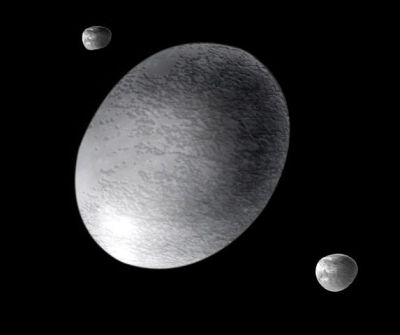18 September 2008

Image credit: NASA/http://Hubblesite.org/
On 17 September 2008, the International Astronomical Union (IAU) announced that the object previously known as 2003 EL61 is to be classified as the fifth dwarf planet in the Solar System and named Haumea, after the mythological Hawaiian goddess of childbirth and fertility.
The decision was made after discussions by members of the IAU's Committee on Small Body Nomenclature (CSBN) and the IAU Working Group for Planetary System Nomenclature (WGPSN). Now the family of dwarf planets consists of five members: Ceres, Pluto, Haumea, Eris and Makemake.
The discovery of Haumea was announced in July 2005. It is a bizarre object with an oblong shape, resembling a melon. Its diameter is approximately the same as that of Pluto (approximately 2,300 km across); however, its exotic shape means that it is much thinner. Its axial rotation is also very fast; Haumea rotates about its axis every four hours, approximately. Some scientists believe that this rapid spin could be responsible for Haumea’s shape; the dwarf planet has been flattened by its swift spin.
Haumea sits among the trans-Neptunian objects, distant cold and rocky bodies orbiting the Sun in the far outreaches of the Solar System. While the Earth orbits the Sun in a nearly circular orbit, Haumea orbits the Sun in a markedly elliptical orbit. Currently, Haumea is roughly 7,500 million km (50 times the Sun-Earth distance) from the Sun, but it comes to within about 5,000 million km from the Sun at perihelion, the closest point to the Sun along a heliocentric orbit.
Interestingly, in Hawaiian mythology, the goddess Haumea also represents the element of stone. Therefore the dwarf planet’s name is particularly apt, as observations of Haumea indicate that, unusually, the dwarf planet is almost entirely composed of rock with a crust of pure ice.
Hawaiian mythology says that the goddess Haumea's children sprang from different parts of her body. The dwarf planet Haumea has a similar history, as it is orbited by two moons that are thought to have been created by ancient impacts with Haumea. During these impacts, parts of Haumea's icy surface were blasted off. The two moons are believed to have formed from the debris from these impacts.
After their discovery, in 2005, the moons were also given provisional designations, but have now too been assigned names by the CSBN and the WGPSN. The first and larger moon is to be called Hi'iaka, after the Hawaiian goddess who is said to have been born from the mouth of Haumea. The second moon of Haumea is named Namaka, a water spirit who is said to have been born from Haumea's body.
The IAU is the international authority for assigning designations to celestial bodies and their surface features on them. It was established in 1919.
References
The IAU Website
Wikipedia
Aymen Mohamed Ibrahem
Senior Astronomy Specialist